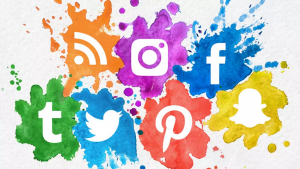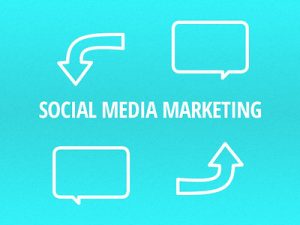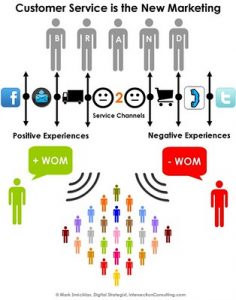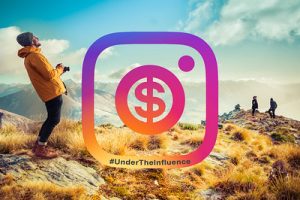31 Social Media Marketing
Alexis Eckerson
31.1. Introduction
Keywords
- Word of mouth– a consumer’s interest in a product or service is reflected through daily dialogue
- Content creator– someone who creates entertaining or educational material
- Micro influencers– an influencer with 10,000- 50,000 followers, with a particular area of interest and high engagement
- Vanity metrics– measurements that make you look good but do not help the business otherwise
- Customer engagement– communication between the consumer and organization through various communication channels
- Conversions– when a visitor to you website completes a common goal
Learning Objectives
- What is social media marketing
- Pros and cons of using social media marketing within a business
- The influence of content creators and influencers
31.2 Social Media Marketing
Social media has taken the digital age by storm, 90.4% of millennials, 77.5% of Generation X and 48.2% of Baby Boomers are on social media. Social media refers to the interactions among people on a digital platform in which they create, exchange and share information and ideas. It encompasses a large variety of websites and apps. Social media has created a way for people to share and access information and content in real and efficient time. It has found a place in a world of digital marketing that has overall reshaped consumer behavior and businesses as a whole.

”File:Social-media-1.webp – Wikimedia Commons” by صفيه سالم محمد الدرعيis licensed under CC- BY-SA 4.0
Social media channels have become an important avenue for new business strategies. Social media marketing “ is the use of social networks to market a business’s product or service (Henderson, 2020). This content is tailored for each different platform in order to drive engagement and promote the business. Social media marketing affects the growth of business, reach of target demographic and the communication between a consumer and seller. Within this chapter, we will look at the foundation of social media marketing, the benefits and challenges, as well as the impact of influencers within business strategies.

“Social Media Marketing” by Jerry Nihen is licensed by CC-BY-2.0.
31.3 Steps for Business and Creative strategies in Social media marketing
Key Takeaway
31.3.1 Steps of Social Media Marketing within a Business
The first step to social media marketing within a business is to learn and establish the businesses goals and values. Without setting goals and objectives for not only the company, but the social outreach, you will have no way of measuring success or your returns on investment. Tracking meaningful engagements is important. Two different types of measuring tools are vanity metrics and targets. Vanity metrics include data collected and displayed on media pages such as followers, page views, retweets or subscribers. While vanity metrics are fun and easy to track, it does not have much effect on business goals. Businesses in particular should focus on targets, such as generated leads, web referrals and conversion rate. Another important step to take is getting to know your audience. Gather real world data, find out where your audience is from, their age demographic, or what language they speak. These insights will allow you to refine and better target your audience (Hootsuite, 2021). As well as the audience, it is an important step to research competitors, in which you can learn from and observe what they are doing. With the technology we have today, it is easy to track competitors. Doing this can help you analyze where your competitors place priority on their marketing and figure out where the market is underserved.
31.3.2 Branding
Social media serves as a channel marketing for activities, customer relationship, buyer research, paid advertising and sales promotion. Branding is another important aspect that is channeled through social media. It increases brand awareness and like-ability. This increase of brand awareness brings customer engagement, loyalty and inspires word of mouth (Ashley and Tuten, 2014). Customer engagement is behavior based and extends beyond the purchase. As the brand increases, so does customer engagement which can also lead to the increase of word of mouth. One type of word of mouth communication we see is influence impressions which is as a form of earned media shared, via social channels. Customer engagement and brand management are two important aspects of digital marketing within a business plan.

“Customer Service is the New Marketing” by Mark Smicklas is licensed by CC BY-NC-2.0.
31.4 Pros and Cons
Key Takeaway
31.4.1 Advantages of Social Media Marketing:
First, we will discuss the benefits of integrating social media marketing into business strategies. The first positive of social media marketing is that it is cost effective. Signing up and creating social media accounts are practically, if not completely free. If you choose to participate in any paid promotions on social networks, they tend to be at a low cost compared to other tactics. Starting small and not worrying about a budget is beneficial. Once you have a better feel of what to expect, you can slowly increase your budget to expand conversions (DeMars, 2014). Conversions in digital marketing, refers to the percentage of visitors converting based on your social media efforts. Conversions tend to be higher due to a few factors that social media allows for, but that other types of marketing do not. One of these factors is the fact that social media makes the company seem more humanized (Blue Foundation 2021). Social media is a place where brands can communicate and act just as people do. Another factor is the idea of trust and credibility that is attached with the stereotype of having a higher number of followers. This idea also leads to the fact there is now high inbound traffic, meaning the more social profiles you have, the more links you have that lead consumers to your page. All of these aspects contribute to the increase of brand awareness (DeMars, 2014). Lastly we look at customer experiences, due to social media companies are to grow their relationships with their consumers as well as create another communication channel for consumers to relay messages. As listed above, digital marketing has many benefits for companies and businesses when they use social media, it is cost effective, increases conversions, grows traffic and influences customer experience.
31.4.2 Disadvantages of Social Media Marketing:
Although there are many positives and benefits for social media marketing, we can also evaluate the negatives that this marketing tactic holds for businesses. The last positive we talked about was the benefit of having another communication channel for consumers. Although this can be a positive, it can be seen as a negative due to the fact consumers can publicly tarnish your company. People have easy access to the internet and have the freedom to say what they want. Another negative that arises from social media are the security and privacy terms. You have to surrender your public and private information in order to get the most out of the marketing tactic on social networks. Lastly, social media is time consuming, you must post consistently, create new content weekly and engage with your audience. You must find a balance between posting, monitoring content while also looking at the impact of your content. One way to overcome this disadvantage is to outsource your marketing team. Disadvantages within digital marketing tend to become more prevalent when a lack of knowledge and education about the topic is there.
31.5 Impact influencers
Key Takeaway
31.5.1 Influencers
A massive powerhouse that has swarmed social media is influencers. Social media influencers, SMI, are a new type of third party influencer who endorse and shape the minds and attitudes of consumers through many types of social networks. The power of social influencers have become prominent and persuasive. Due to this, new technologies have been created in order to track and identify influencers. Most of these tactics rely on factors such as daily hits on blogs, posts and or the number of followers they have
Usually influencers have some sort of niche that they play to in order to create a following. These influencers are content creators, generating new videos, posts, or even blogs. The benefits of having an influencer promote your brand include brand credibility, the reach of a relative audience and brand awareness. Stats have shown that 49% of consumers make their purchasing decisions based on recommendations of influencers they follow (Stevens Tate, 2019).
31.5.2 Micro Influencers
Influencers are a strategy that is slowly taking over social media. Due to the growth of influencers, micro influencers, which are influencers with smaller followings have become a larger advantage in social media marketing. This is because micro influencers have higher engagement among their audiences. Additionally, they tend to charge less than more popular creators with large sponsored content.

https://www.flickr.com/photos/95572727@N00/47752429552 by Trey Ratcliff is licensed by CC-BY-NC-SA 2.0.
31.6 Future Outlook
Looking into the future there are trends that are slowly taking over social network sites that will keep growing through the years. As mentioned above, influencers are taking over social media. We can see that more and more types and levels of influencers are being created, which is ultimately setting the stage for influencers to become a larger part of marketing.
Another aspect of social media and digital marketing that might expand is the idea of driving sales through social media. As it becomes more popular to publish and promote products via social media, it will become easier to track engagements on social networks, which will help increase sales. Lastly, as mentioned before, social media is causing companies to be more transparent. As brands become more transparent, it builds more brand loyalty and trust between the consumer and company.
As many companies see the benefit and effectiveness of social media marketing, I believe these aspects and strategies will start to take over many marketing tactics throughout businesses all over. New technologies have made tracking engagement easier and influencers have made social media a platform for promotion. It will continue to grow and adapt to new and improved technologies.
Cast Study: Dove-Connecting the Target
Dove is a beauty brand under Unilever, and after getting lost in the sea of beauty competitors they knew they needed a new face. This is when they started their Real Beauty campaign. This campaign challenges the negative stereotypes that have evolved in the beauty industry over time. Dove asked women to post photos of themselves embracing their found beauty and confidence, with the hashtag, #mydovemessages. These messages and images supporting women and dove products are posted all throughout different social networks. The Real Beauty Campaign managed to draw emotion and create positive brand associations.
To start the campaign, they posted inspirational photos and videos, which Facebook and Twitter, were primarily used for these posts. According to Twitter, the #SpeakBeautiful hashtag, one used in the campaign led to a huge change in the way women talk online. Negative tweets about beauty and body image dropped from over 5.3 million in 2014 to 3.4 million in 2015–a 36.8% decrease year over year (Griffin 2021). On the other hand, women from all different stages in life were asked to participate in Dove videos on Youtube (Sriram 21). The campaign itself has won two awards and increased sales by millions. Before the campaign started their sales were at 2.5 billion and were soon increased to 4 billion with the addition of this campaign.
Chapter Summary
Within this chapter, we explored some of the important steps of social media marketing like setting goals and objectives, tracking engagements, understanding your audience and competitors. We also take a look at the benefits and disadvantages of social media marketing and how those influence businesses and consumers. We see how all topics of social media marketing intertwine with each other to create this cohesive yet powerful market that is the internet. Influencers have become a major persuasion in digital marketing and social networking sites. Looking forward to the future, we can expect to see the growth of influencers, transparency, and sales through social media. As new technologies are being implemented to help digital marketing be more effective and transparent with the engagement, we can look forward to seeing the increase of media usage.
Review Questions
1. Influencers who have less followers but higher engagement are…
A. A social media influencers
B. Micro Influencers
C. Macro Influencers
D. Minor Influencers
2. Which is not an advantage to social media marketing?
A. Security and Privacy Terms and agreements
B. Consumer Communication Lines
C. High Conversion rates
D. High inbound traffic
3. What are the two types of measuring tools for media engagement?
A. Vanity Metrics and Consumer engagement
B. Social meter and Target audience
C. Target and Twitter engagement
D. Vanity Metrics and Target
Answers:
-
- B
- A
- D
Food for Thought
- How might social media marketing affect small businesses or start up businesses?
- In what way have influencers changed the game of digital marketing? How do you see this aspect of media influencers continuing to grow?
References
Constantinides, E. (2014, September 29). Foundations of social media marketing. Procedia – Social and Behavioral Sciences. Retrieved November 9, 2021, from https://www.sciencedirect.com/science/article/pii/S1877042814039202.
DeMers , J. (2014). The Top Ten Benefits of Social Media Marketing. Forbes . Retrieved 2021, from https://archive.newportbeachlibrary.org/NBPL/0/edoc/777341/9102015%20-%20City%20Arts%20Commission%20-%2006%20Importance%20of%20Social%20Media%20-%20ATTACHMENT%20A.pdf.
Freberg, K., Graham, K., McGaughey, K., & Freberg, L. A. (2010, December 4). Who are the social media influencers? A study of public perceptions of personality. Public Relations Review. https://www.sciencedirect.com/science/article/abs/pii/S0363811110001207.
Frey, B., & Rudloff, S. (2021). Social Media and the impact on marketing … – diva portal. Diva Portal https://www.diva-portal.org/smash/get/diva2:1030631/FULLTEXT01.pdf.
Saravanakumar, M., & SuganthaLakshmi, T. (1998). Life science journal 9(4) http://www.lifesciencesite … Life Science Site. http://www.lifesciencesite.com/lsj/life0904/670_13061life0904_4444_4451.pdf.
Media, W. B. B. F. (2021). 10 advantages of social media marketing for your business. Blue Fountain Media. https://www.bluefountainmedia.com/blog/advantages-of-social-media-marketing.
Wagner, N. (2019, October 24). The power of social media influencers: Why it works – S&T. Stevens & Tate Marketing https://stevens-tate.com/articles/the-power-of-social-media-influencers-why-it-works/.
Measurements that make you look good but do not help the business otherwise.
Communication between the consumer and organization through various communication channels.
A consumer’s interest in a product or service is reflected through daily dialogue.
When a visitor to you website completes a common goal.
Someone who creates entertaining or educational material.
An influencer with 10,000- 50,000 followers, with a particular area of interest and high engagement.

